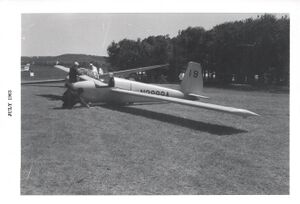Engineering:Schweizer SGS 1-29
| SGS 1-29 | |
|---|---|

| |
| Paul Schweizer's 1-29 at the 1963 US Soaring Championships at Harris Hill, Elmira, NY | |
| Role | Experimental Standard-class sailplane |
| National origin | United States |
| Manufacturer | Schweizer Aircraft Corporation |
| Designer | Ernest Schweizer[1] |
| First flight | 1958[2] |
| Number built | 1 |
The Schweizer SGS 1-29 is an American single-seat, mid-wing, experimental laminar flow airfoil glider built by Schweizer Aircraft of Elmira, New York.[3]
The 1-29 is a development of the Schweizer SGS 1-23 that utilizes a 1-23 fuselage and a newly constructed set of 49.2 foot (15.0 m) span wings.[1][3]
The aircraft was constructed to study the feasibility of producing improved boundary layer laminar flow on a metal-winged sailplane. Only one SGS 1-29 was produced and the project was not pursued further.[1][2][3]
Background
In the mid-1950s the SGS 1-23 was in full production and through successive models was performing very well in competition. By 1957 the development of fiberglass-reinforced plastic affected the production of many sporting goods, such as boats and fishing rods. Schweizer Aircraft thought it was only a matter of time before a fiberglass sailplane was produced. This concern was borne out in 1965, when two German fiberglass sailplanes were entered in the world championships.[2]
Schweizer Aircraft evaluated the use of fiberglass for sailplane construction and rejected it for several reasons:[2]
- The high cost of demonstrating to the Federal Aviation Administration that this new material could safely be used for aircraft primary structure.[2]
- Problems with crash resistance of fiberglass structures in high impact accidents.[2]
- The unknown service life of fiberglass.[2]
- The high degree of manual labor required to do fiberglass lay-ups at that time and the associated cost.[2]
The company decided to concentrate on getting the best performance from the material that it knew best, aluminum.[2]
Schweizer created several design studies of new sailplanes in the mid-1950s. These included:[2][4]
Of these, only the SGS 1-29 proceeded to prototype stage.[2][3]
Design and development
The 1-29 was constructed using a modified SGS 1-23G fuselage. New wings were built for the aircraft to determine if better laminar flow could be achieved on a metal wing.[1][3]
The wings were all-metal and of constant chord. The wing ribs were identical and created from a single master die to ensure uniformity. The wing features a thick, deep spar to reduce wing flexing and "oil-canning" that might interrupt laminar flow. The wing was assembled using flush rivets and has balanced top and bottom dive brakes.[1][3]
The aircraft first flew in 1958 and flight testing was reported by Schweizer Aircraft as on-going through 1959.[2]
The 1-29 program did yield positive results. The standard production model SGS 1-23H-15 with the same fuselage and wingspan as the 1-29 and a NACA 43012A airfoil, produced a best glide ratio of 29:1. With its laminar flow wing and NACA 63-618 airfoil the 1-29 recorded a 34:1 glide ratio, an improvement of 15%.[3]
The 1-29 design was never certified and the sole aircraft that was built is an experimental aircraft in the "racing, exhibition" class and registered as N3898A.[3][5]
Operational history
The 1-29 was flown in at least three US national competitions by Paul A Schweizer, Bill Ivans and Tom Smith.[3]
Aircraft on display
Once the 1-29 test program was complete, the aircraft was donated to the National Soaring Museum where it is currently listed as being in storage.[6]
Specifications
General characteristics
- Crew: One
- Wingspan: 49 ft 3 in (15.00 m)
- Wing area: 154 sq ft (15.3 m2)
- Aspect ratio: 15.75
- Airfoil: NACA 63-618
- Empty weight: 465 lb (224 kg)
- Gross weight: 750 lb (340 kg)
Performance
- Maximum glide ratio: 34 at 52 mph (83 km/h)
- Rate of sink: 123 ft/min (0.63 m/s)
See also
Related lists
References
- ↑ 1.0 1.1 1.2 1.3 1.4 Activate Media (2006). "SGS 1-29 Schweizer". Archived from the original on 2007-08-08. https://web.archive.org/web/20070808195108/http://www.sailplanedirectory.com/PlaneDetails.cfm?planeID=308. Retrieved 2008-05-27.
- ↑ 2.00 2.01 2.02 2.03 2.04 2.05 2.06 2.07 2.08 2.09 2.10 2.11 Schweizer, Paul A: Wings Like Eagles, The Story of Soaring in the United States, pages 159-209. Smithsonian Institution Press, 1988. ISBN:0-87474-828-3
- ↑ 3.0 3.1 3.2 3.3 3.4 3.5 3.6 3.7 3.8 Said, Bob: 1983 Sailplane Directory, Soaring Magazine, page 32. Soaring Society of America, November 1983. USPS 499-920
- ↑ 4.0 4.1 4.2 4.3 Smithsonian Institution (2004). "Directory of Airplanes". http://siris-thesauri.si.edu/ipac20/ipac.jsp?session=L21C5106397I7.28&profile=planes&uri=link=3100020~!50526~!3100001~!3100002&aspect=subtab13&menu=search&ri=4&source=~!sithesauri&term=Schweizer+7+28&index=. Retrieved 2008-05-13.
- ↑ Federal Aviation Administration (May 2008). "FAA Registry". http://registry.faa.gov/aircraftinquiry/NNumSQL.asp?verified=1&NNumbertxt=3898A. Retrieved 2008-05-27.
- ↑ Munson, J. (n.d.). "Sailplanes in Our Collection". Archived from the original on 2011-05-16. https://web.archive.org/web/20110516142717/http://www.soaringmuseum.org/collection.html. Retrieved 2008-04-15.
External links
 |

